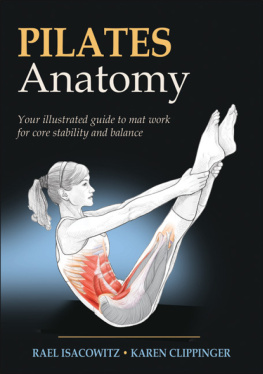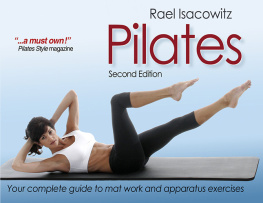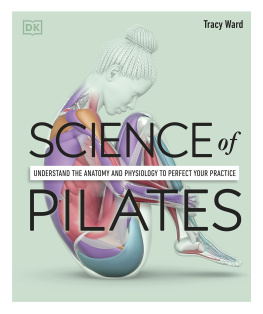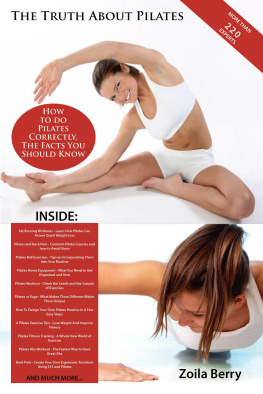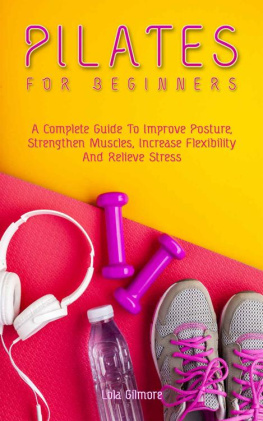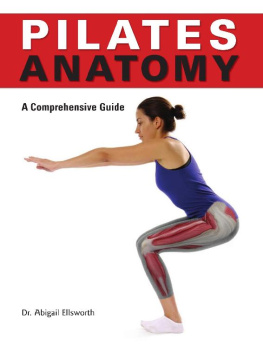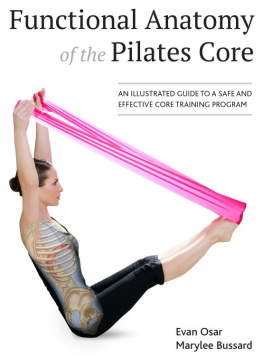PILATES ANATOMY
Rael Isacowitz
Karen Clippinger

Human Kinetics
Library of Congress Cataloging-in-Publication Data
Isacowitz, Rael, 1955
Pilates anatomy / Rael Isacowitz, Karen Clippinger.
p. cm.
Includes bibliographical references.
ISBN-13: 978-0-7360-8386-7 (soft cover)
ISBN-10: 0-7360-8386-3 (soft cover)
1. Pilates method. I. Clippinger, Karen S. II. Title.
RA781.4.I74 2011
613.7192--dc22
2010046031
ISBN-10: 0-7360-8386-3 (print)
ISBN-13: 978-0-7360-8386-7 (print)
Copyright 2011 by Rael Isacowitz and Karen Clippinger
All rights reserved. Except for use in a review, the reproduction or utilization of this work in any form or by any electronic, mechanical, or other means, now known or hereafter invented, including xerography, photocopying, and recording, and in any information storage and retrieval system, is forbidden without the written permission of the publisher.
This publication is written and published to provide accurate and authoritative information relevant to the subject matter presented. It is published and sold with the understanding that the author and publisher are not engaged in rendering legal, medical, or other professional services by reason of their authorship or publication of this work. If medical or other expert assistance is required, the services of a competent professional person should be sought.
Acquisitions Editor: Tom Heine; Developmental Editor: Cynthia McEntire; Assistant Editor: Laura Podeschi; Copyeditor: Patricia L. MacDonald; Graphic Designer: Fred Starbird; Graphic Artist: Francine Hamerski; Cover Designer: Keith Blomberg; Cover Model (for illustration reference): Lisa Clayton Hubbard; Photographer (for illustration references): Neil Bernstein; Interior Models (for illustration references): Devon Reuvekamp, Lisa Clayton Hubbard, Stephanie Powel, Yuki Yoshii; Visual Production Assistant: Joyce Brumfield; Art Manager: Kelly Hendren; Illustrator: Molly Borman; Printer: Versa Press
Human Kinetics books are available at special discounts for bulk purchase. Special editions or book excerpts can also be created to specification. For details, contact the Special Sales Manager at Human Kinetics.
Printed in the United States of America 10 9 8 7 6 5 4 3
The paper in this book is certified under a sustainable forestry program.
Human Kinetics
Web site: www.HumanKinetics.com
United States: Human Kinetics
P.O. Box 5076
Champaign, IL 61825-5076
800-747-4457
e-mail: humank@hkusa.com
Canada: Human Kinetics
475 Devonshire Road Unit 100
Windsor, ON N8Y 2L5
800-465-7301 (in Canada only)
e-mail: info@hkcanada.com
Europe: Human Kinetics
107 Bradford Road
Stanningley
Leeds LS28 6AT, United Kingdom
+44 (0) 113 255 5665
e-mail: hk@hkeurope.com
Australia: Human Kinetics
57A Price Avenue
Lower Mitcham, South Australia 5062
08 8372 0999
e-mail: info@hkaustralia.com
New Zealand: Human Kinetics
P.O. Box 80
Torrens Park, South Australia 5062 0800 222 062
e-mail: info@hknewzealand.com
E4827
Converted to eBook by EasyEPUB
To Joseph and Clara Pilates and the many dedicated teachers who have kept their vision alive
Preface
I n recent years, a profound evolution of Pilates has occurred. The Pilates industry seemed to reach a tipping point (a point of critical mass) in the mid- to late 1990s, whereby it morphed from a little-known form of exercise with a devout but small following including dancers, singers, circus performers, and actors to a mainstream fitness regimen practiced in many households. It suddenly started appearing in Hollywood movies and television commercials, in cartoons and comedy shows, and on late-night television. It became synonymous with going to Starbucks and indulging in a low-fat triple-shot soy latte (no whipped cream please!).
How this happened, why this happened, and to what this phenomenon can be attributed remain somewhat of an enigma. However, few can dispute that the growth of active participants in the United States from approximately 1.7 million in 2000 to approximately 10.6 million in 2006 is a phenomenon. Worldwide participation also has exploded.
Of course, all growth comes with growing pains, and the Pilates industry is no exception. The accelerated education, which is often a part of rapid growth, has certainly taken hold in Pilates. Although we favor a more comprehensive approach, the accelerated approach has been one part of the expansion of Pilates that has led to a multitude of positive outcomes, such as Pilates filtering into many new arenas including fitness clubs, training programs for athletes, and medical facilities.
Understanding Pilates requires some knowledge of its history. Joseph Pilates was born on December 9, 1883, near Dsseldorf, Germany. He died on October 9, 1967. Unfortunately he didnt live to see the realization of his dreams. He adamantly believed that his approach to total well-being should be embraced by the masses and certainly by health care professionals. He hoped that contrology, as he called his system, would be taught in schools throughout the United States. He intended his method to be a mainstream form of conditioning for men, and initially it was practiced more by men, although it is largely women who have kept the flame alive all these years.
It is fortunate that several early students of Mr. Pilates and his wife, Clara, whom he met on his second trip to the United States in 1926 and who became his lifelong partner in his work, survived them and became exceptional teachers in their own right. These first-generation Pilates teachers, taught directly by Joseph and Clara Pilates, have played a profound role in the evolution of the Pilates industry. Rael Isacowitz has had the distinct privilege of studying with several members of this unique group over the past 30 years. Ms. Kathleen Stanford Grant must be singled out as having a particularly powerful effect on this authors development and teaching style.
Joseph Pilates did not leave extensive written materials to guide future generations of Pilates professionals. The limited archival materialphotographs, films, and textshave been very valuable. However, mainly word of mouth and the universal language of movement have been used to pass much of his teachings down from first generation to second and on to following generations. Mr. Pilates did write two short books, and one of them, Return to Life Through Contrology, served as the primary reference for Pilates Anatomy. The decision to use the exercises as they appear in Return to Life Through Contrology as the basis for the primary descriptions of most exercises in Pilates Anatomy was an important one. Our goal is for Pilates Anatomy to transcend teaching styles, individual approaches to Pilates, or any particular school of Pilates. This book is written to be universal in its appeal, just as anatomy itself is universal. Using Return to Life Through Contrology brings the work as close to the source as one can get, with the intent that

